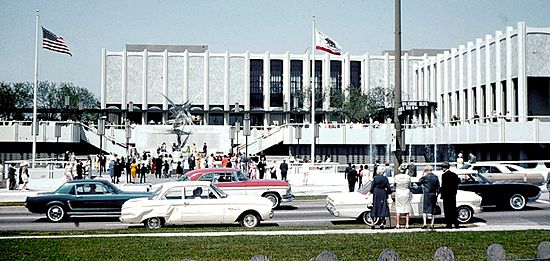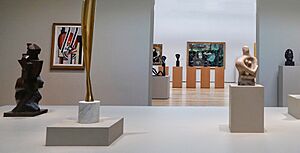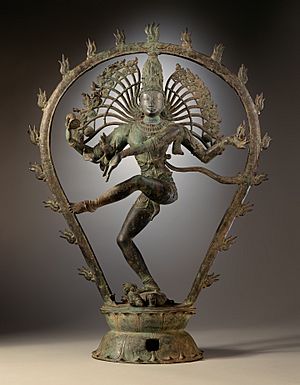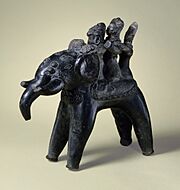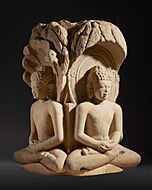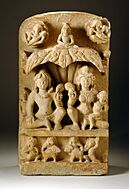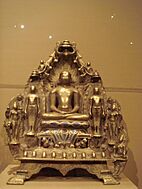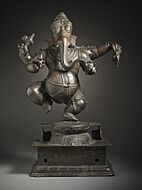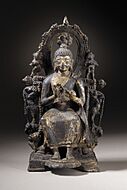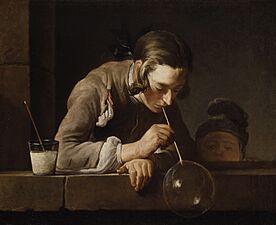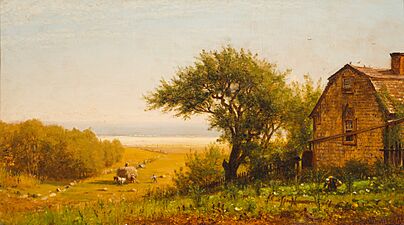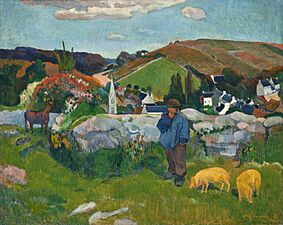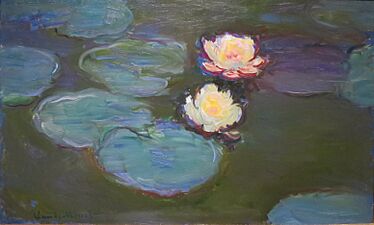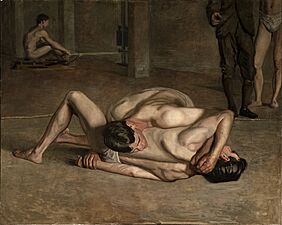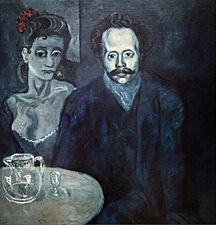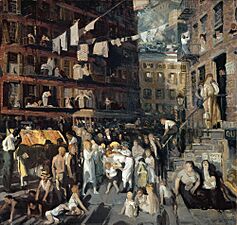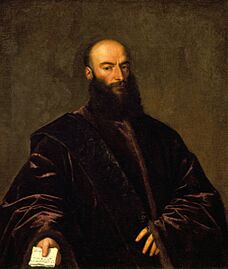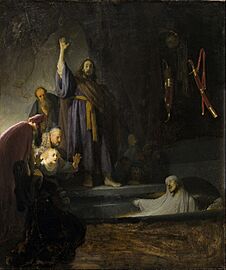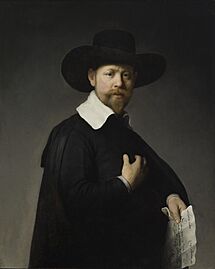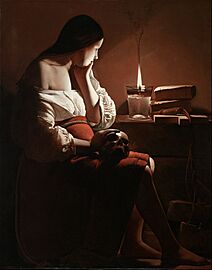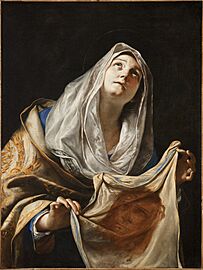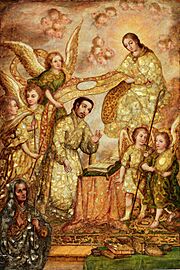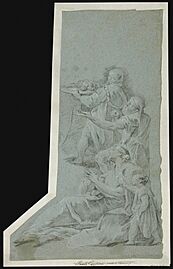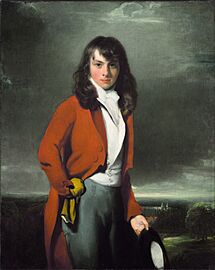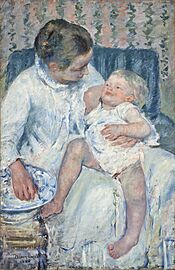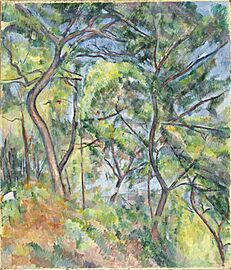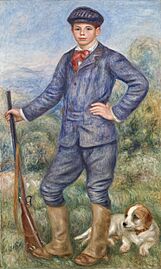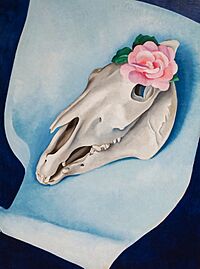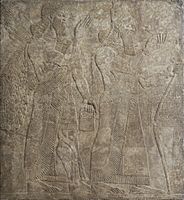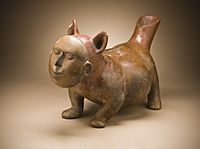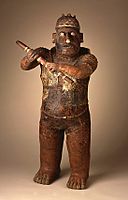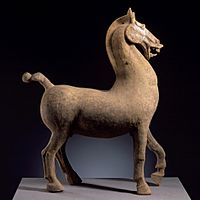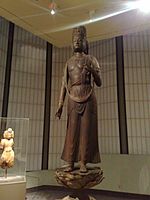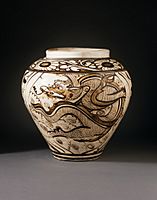Los Angeles County Museum of Art facts for kids
 |
|

Museum pavilion, 2014, prior to demolition
|
|
| Established | 1910 |
|---|---|
| Location | 5905 Wilshire Boulevard Los Angeles United States |
| Type | Encyclopedic, Art museum |
| Visitors | 1,592,101 (2016) |
| Architect | William Pereira (1965) Hardy Holzman Pfeiffer Associates (1986) Bruce Goff (1988) |
| Public transit access | Bus: 20, 217, 720 or 780 to Wilshire Bl and Fairfax Av Future Rail: Wilshire/Fairfax (service to begin in 2025) |
The Los Angeles County Museum of Art (LACMA) is a famous art museum in Los Angeles, California. It is located on Wilshire Boulevard in an area called Miracle Mile. LACMA is right next to the La Brea Tar Pits, which is another cool place to visit.
LACMA started in 1961, separating from the Los Angeles Museum of History, Science and Art. A few years later, it moved to its own special buildings on Wilshire Boulevard. The museum's art collection grew a lot in the 1980s, and new buildings were added over the years.
Today, LACMA is the largest art museum in the western United States. Almost a million people visit it every year! It has over 150,000 artworks from ancient times to today. Besides art shows, LACMA also has film screenings and concerts.
Contents
History of LACMA
How LACMA Started
The Los Angeles County Museum of Art became its own museum in 1961. Before that, it was part of the Los Angeles Museum of History, Science and Art, which opened in 1910. That first museum was located near the University of Southern California.
Some important people, like Edward W. Carter, helped raise money to create LACMA. This happened because a wealthy art collector named J. Paul Getty was not happy with how his art donations were displayed at the old museum. He decided to open his own art museum instead.
Howard F. Ahmanson, Sr., Anna Bing Arnold, and Bart Lytton were the first big supporters of the new art museum. Ahmanson gave $2 million, which helped convince others that the new museum could be built. In 1965, LACMA moved to its new home on Wilshire Boulevard. It was the biggest new museum built in the United States since the National Gallery of Art.
The First Buildings
The first buildings at LACMA were designed by architect William Pereira. They looked similar to other big buildings like Lincoln Center in New York. There were three main buildings: the Ahmanson Building, the Bing Center, and the Lytton Gallery (which was later renamed the Frances and Armand Hammer Building). Building these cost $11.5 million and finished in 1965. When the museum first opened, the buildings had reflecting pools around them. But these pools had to be filled in because tar from the nearby La Brea Tar Pits started leaking into them!
Growth in the 1980s
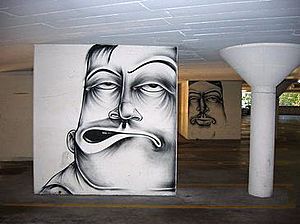

LACMA received a lot of donations in the 1980s, about $209 million. To make space for its growing collections of modern and contemporary art, the museum added the Robert O. Anderson Building in 1986. This building was later renamed the Art of the Americas Building. With this expansion, visitors started entering through a new central court, which was almost an acre in size.
The museum also opened its Pavilion for Japanese Art in 1988, designed by architect Bruce Goff. The B. Gerald Cantor Sculpture Garden, featuring Rodin bronze sculptures, also opened that year.
In 1999, the park next to LACMA, Hancock Park, was improved. It got picnic areas, walkways, and a special amphitheater designed by artist Jackie Ferrara.
Also in 1994, LACMA bought the old May Company department store building next door. This building is a great example of Streamline Moderne architecture. When it opened as LACMA West in 1998, it made the museum 30 percent larger.
New Buildings by Renzo Piano
In 2004, LACMA planned a big change for the museum with architect Rem Koolhaas. However, this plan did not happen because the museum could not get enough money. Later in 2004, LACMA decided to work with architect Renzo Piano instead. His plan involved three phases of changes.
The first phase started in 2004 and finished in 2008. This included building the BP Grand Entrance and the Broad Contemporary Art Museum (BCAM). BCAM was named after Eli and Edy Broad, who gave $60 million to the museum. BCAM opened in February 2008, adding a lot of new space for art. In 2010, the Lynda and Stewart Resnick Exhibition Pavilion also opened. It is a large, naturally lit space for exhibitions.
The second and third phases of Renzo Piano's plan were never finished.
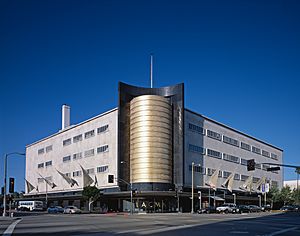
The Zumthor Building Project
In 2009, LACMA announced plans for a new building designed by Swiss architect Peter Zumthor. This new building would replace the older Pereira Buildings. The first idea was for a large glass building that would stretch across Wilshire Boulevard.
In June 2014, the Los Angeles County Board of Supervisors approved money for LACMA to continue with Zumthor's plans. On April 8, 2019, the final design for the Zumthor building was approved. The new design was smaller and changed to a sand-colored concrete building with glass walls. It still includes a part that goes over Wilshire Boulevard.
The new building's second floor will be entirely for art galleries. Other areas like the education department, shop, and restaurants are on the ground level. There is also a theater with 300 seats.
The total cost for this project was estimated at $750 million by 2023. LACMA raised a lot of money for it.
In 2020, four of the old buildings on the campus were torn down to make way for the new facility. This design caused some debate among architects and people in Los Angeles. Some felt it reduced gallery space and was too expensive. A campaign called "Save LACMA" was started. Demolition of the old buildings finished in October 2020. Construction slowed down in 2021 because fossils were found on the site. The opening of the Zumthor building was delayed to 2026. As of July 2025, parts of the plaza around the Zumthor Building were expected to open in mid-2025.
Museum Partnerships
Watts Towers
In 2010, LACMA started working with the City of Los Angeles to help protect the Watts Towers. LACMA offered its staff and help with fundraising. As of 2018, LACMA was working with Los Angeles County on a new site near the Watts Towers.
South Los Angeles Wetlands Park
In 2018, LACMA got a long-term lease for a large building in the South Los Angeles Wetlands Park area. This building used to be a maintenance yard.
Las Vegas Museum of Art
In 2023, LACMA teamed up with philanthropist Elaine Wynn to create the Las Vegas Museum of Art (LVMA). The Las Vegas city council approved plans for a new 90,000-square-foot building for this museum.
Exhibitions and Shows
LACMA has hosted many exciting exhibitions over the years. In 1971, the "Art and Technology" exhibit opened, showing how art and new inventions could work together. Later that year, the museum featured works by contemporary Black artists.
One of the most popular shows ever was "Treasures of Tutankhamun" in 1978, which attracted 1.2 million visitors! Another Tutankhamun show in 2005 also drew many people. Other popular shows included masterpieces by Vincent van Gogh and French Impressionist art.
More recently, LACMA has had popular exhibits about movie directors like Tim Burton and Stanley Kubrick. These shows were very well-received by both critics and visitors.
Art Collections
LACMA has over 120,000 art objects, organized into different departments based on where they came from, what they are made of, and their time period. These collections are spread across the various museum buildings.
Modern and Contemporary Art
The Modern Art collection is in the Ahmanson Building. In 2008, this building was updated with a new entrance and a large staircase, like the famous Spanish Steps in Rome. At the bottom of the staircase is a huge sculpture called Smoke (1967) by Tony Smith. This area also has African art and German Expressionist art.
The modern collection includes works from the 1900s to the 1970s. A big part of this collection came from Janice and Henri Lazarof, who gave LACMA 130 modern artworks in 2007. This gift included 20 works by Picasso, paintings by Paul Klee and Wassily Kandinsky, and sculptures by Alberto Giacometti, Constantin Brâncuși, and Henry Moore.
The Contemporary Art collection is in the Broad Contemporary Art Museum (BCAM), which opened in 2008. Its first show featured 176 works by 28 artists from the late 1950s to today. Most of these works came from the collection of Eli and Edythe Broad.
One famous sculpture is Back Seat Dodge '38 (1964) by Edward Kienholz. This artwork caused a lot of discussion when it was first shown in 1966. People lined up to see it, and it has been a popular piece ever since.
American and Latin American Art
The Art of the Americas Building holds American, Latin American, and pre-Columbian art collections on its second floor. The first floor is used for temporary exhibitions.
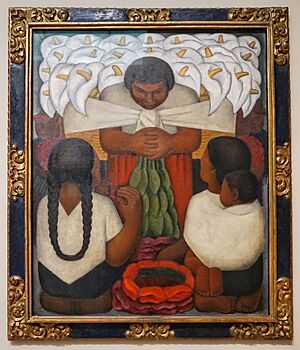
LACMA's Latin American Art galleries were renovated and reopened in 2008. This collection includes art from before Columbus arrived in the Americas, Spanish Colonial art, and modern and contemporary works. Many new pieces were added thanks to sales from a large collection of 20th-century Mexican art given by Bernard and Edith Lewin in 1997.
The pre-Columbian galleries were redesigned by artist Jorge Pardo. His display cases are made from many layers of wood, creating unique wavy shapes that stand out from the walls.
The museum's pre-Columbian collection started in the 1980s with gifts from collectors like Constance McCormick Fearing and Proctor Stafford. It grew even more with a gift of Colombian ceramics from Camilla Chandler Frost and Stephen and Claudia Muñoz-Kramer. LACMA has one of the largest collections of Latin American art because of a generous donation of over 2,000 artworks from Bernard Lewin and his wife Edith Lewin in 1996.
Asian Art
The Hammer Building houses the Chinese and Korean art collections. The Korean art collection began in 1966 with a gift of ceramics from Bak Jeonghui, who was then the president of South Korea. Today, LACMA has one of the best Korean art collections outside of Korea and Japan. The Pavilion for Japanese Art displays the Shin'enkan collection. In 1999, LACMA trustee Eric Lidow and his wife, Leza, donated 75 ancient Chinese artworks, including important bronze objects and Buddhist sculptures. LACMA also has a rich collection of art from India, mostly sculptures of Jain Tirthankaras, Buddha, and Hindu gods. Many paintings from India are also in the LACMA collection.
Ancient Greek, Roman, and Etruscan Art
The second floor of the Ahmanson Building has galleries for Greek and Roman Art. A large part of this collection was given by William Randolph Hearst, a famous newspaper publisher, in the late 1940s and early 1950s.
Islamic Art
The museum's Islamic galleries have over 1700 artworks. These include ceramics, metalwork, glass, carved stone and wood, and beautiful books with detailed illustrations and Islamic calligraphy. The collection is especially strong in pottery, tiles, and glass from Persia and Turkey. This collection really grew in 1973 when the Nasli M. Heeramaneck Collection was given to the museum.
Decorative Arts and Design
In 1990, Max Palevsky gave 32 pieces of Arts and Crafts furniture to LACMA. He later added more pieces and donated money for more Arts and Crafts works. In 2009, the museum showed "The Arts and Crafts Movement: Masterworks From the Max Palevsky and Jodie Evans Collection." In 2009, LACMA also became a major center for studying 18th and 19th-century European clothing when it bought about 250 outfits and 300 accessories, including suits, dresses, and many shoes and hats.
Permanent Art Installations
Robert Graham created a tall bronze sculpture called Retrospective Column (1981) for the entrance of the Art of the Americas Building. A new sculpture garden opened in 1991, featuring large outdoor sculptures by artists like Alice Aycock, Ellsworth Kelly, and Henry Moore. The main artwork in this garden is Alexander Calder's mobile Hello Girls, which was made for the museum's opening in 1965.
The Ahmanson Building's main hall was changed to hold Tony Smith's Smoke, a huge black aluminum sculpture that is 45 feet long, 33 feet wide, and 22 feet high. This artwork was acquired by the museum in 2010.
Eli and Edythe Broad gave $10 million to help buy Richard Serra's Band sculpture, which is on display on the first floor of BCAM.

Around the BCAM building and LACMA's courtyard, there is a garden with 100 palm trees, designed by artist Robert Irwin. Many of these trees are in large wooden boxes. Right in front of the new entrance on Wilshire Boulevard is Chris Burden's Urban Light (2008). This is an amazing display of 202 old cast-iron street lights from different cities around Los Angeles. The lights work, turning on in the evening, and are powered by solar panels.
Artist Jeff Koons had planned a very tall sculpture featuring a 1940s locomotive hanging from a crane at the museum's entrance. However, this project faced challenges with fundraising and construction, and it has not been completed.
Levitated Mass by artist Michael Heizer is another impressive artwork at LACMA. This huge 340-ton boulder, 21.5 feet wide and 21.5 feet high, was moved from Riverside County to LACMA in 2012. It sits on top of a 456-foot-long trench, allowing people to walk underneath and around the massive rock. The artwork opened to the public on June 24, 2012.
Photography
The Wallis Annenberg Photography Department started in 1984. It has over 15,000 photographs from when photography was invented in 1839 to today. In 1992, Audrey and Sydney Irmas donated their entire photography collection, which created the Audrey and Sydney Irmas Collection of Artists' Self-Portraits. This collection has many self-portraits by famous photographers like Andy Warhol and Edward Steichen. In 2008, the Annenberg Foundation gave $23 million for LACMA to buy the Marjorie and Leonard Vernon collection of 19th and 20th-century photographs. This gift also helped build storage for the museum's photos, leading to the department being renamed the Wallis Annenberg Department of Photography. In 2011, LACMA and the J. Paul Getty Trust together bought over 2,000 artworks and other materials by artist Robert Mapplethorpe.
Film
LACMA has had a film program since the late 1960s. In 2009, the museum considered ending its film series, but after many people, including film director Martin Scorsese, protested, the museum expanded its movie offerings. In 2011, LACMA and the Academy of Motion Picture Arts and Sciences announced plans to open a movie museum in the former May Co. building. The Academy Museum opened in 2022.
Donations and Support
Individual Donors
In 2014, LACMA received a huge donation of art worth $500 million from businessman Jerry Perenchio. This collection includes 47 artworks by famous artists like Paul Cézanne, Edgar Degas, René Magritte, Claude Monet, and Pablo Picasso. This was the biggest gift in the museum's history. Perenchio's donation will happen after his death, but only if the museum finishes building the new Peter Zumthor building.
The $54 million Resnick Pavilion was made possible by a $45 million gift from Lynda and Stewart Resnick. In 2007, BP announced a $25 million donation to name the museum's main entrance the "BP Grand Entrance."
In 2008, Eli Broad decided to keep control of his large collection of modern and contemporary art through his independent Broad Art Foundation. This foundation loans artworks to museums, and LACMA is the "preferred" museum to receive works from it. Eli Broad also paid for the $56-million Broad Contemporary Art Museum (BCAM) building at LACMA and gave an extra $10 million to buy two artworks for it.
In 2002, the Annenberg Foundation gave the museum $10 million to support exhibitions, art purchases, and educational programs. In honor of this gift, LACMA's director position was named the Wallis Annenberg directorship.
Between 1972 and 2020, the Ahmanson Foundation spent about $130 million to help the museum buy 99 artworks. These included masterpieces by Georges de La Tour, Rembrandt, and Bernini.
From 1946 until his death in 1951, William Randolph Hearst was LACMA's biggest supporter. He donated the most objects to the museum, forming its collection of ancient Greek and Roman art, medieval sculptures, and much of the European decorative arts.
Art Councils
Over the years, ten art councils have helped LACMA acquire almost 5,000 artworks. These councils are groups of art lovers who pay dues and raise money for specific parts of the museum's collection. The Art Museum Council, founded in 1952, supports the entire museum. The Modern and Contemporary Art Council, started in 1961, is one of the oldest support groups for contemporary art at any museum.
Collectors Committee
Each year, a special group of donors called the Collectors Committee helps LACMA buy new art for its permanent collection. Members pay a fee to join this group. Once a year, they meet at the museum to hear curators present artworks they want to buy. The members then vote on which artworks should be added to the collection. Since it started in 1986, this event has brought about 170 artworks into the museum's collection. In 2012, the gala raised over $2.8 million.
LACMA Art + Film Gala
The annual Art + Film Gala dinner started in 2011. It features entertainment by international artists and helps the museum get support from Hollywood leaders. Tickets for the gala range from $5,000 to $100,000. The 2022 gala raised over $5.1 million for the museum's operations and collections.
Many famous people have been honored at the gala, including Judy Baca, David Fincher, Helen Pashgian, Park Chan-wook, Betye Saar, Alfonso Cuaron, Catherine Opie, Guillermo del Toro, Mark Bradford, George Lucas, Kathryn Bigelow, Robert Irwin, Alejandro González Iñárritu, James Turrell, Barbara Kruger, Quentin Tarantino, Martin Scorsese, David Hockney, Stanley Kubrick, Ed Ruscha, Clint Eastwood, and John Baldessari.
Museum Programs
In 1966, Maurice Tuchman started the Art and Technology (A&T) program at LACMA. This program connected artists with technology companies to explore new ideas. It led to an exhibition and helped develop the Light and Space art movement.
In 2014, the museum opened its Art + Tech Lab, continuing the legacy of the original Art and Technology program. This lab presents annual projects where artists work with modern technology.
Museum Management
Funding
LACMA is managed by Museum Associates, a non-profit organization. In 2011, the museum had net assets of $300 million. The museum's endowment grew from $99.6 million to $106.8 million that year. The Los Angeles County provides about $29 million a year, covering more than a third of the museum's operating costs.
LACMA usually raises around $40 million from donations and memberships, which pays for almost half of its average expenses of about $92 million.
Attendance
LACMA's attendance has grown over the years. In 2010, it had 914,356 visitors. In 2011, for the first time, the museum welcomed over 1 million visitors. By 2015, attendance reached 1.6 million.
Directors
- Richard (Ric) F. Brown – 1961 – 1966
- Kenneth Donahue – 1966 – 1979
- Earl A. Powell III – 1980 – 1992
- Michael E. Shapiro – 1992 – 1993
- Graham W. J. Beal – 1996 – 1999
- Andrea L. Rich – 1999 – 2005
- Michael Govan – 2006–present
In 1996, LACMA's board decided to split the director's job into two roles: Andrea Rich became president and CEO, while Graham W. J. Beal managed the artistic programs. In 2005, the president's role became the second-highest position again.
LACMA owns a house in Hancock Park for its director. In 2020, Museum Associates bought another house in Mid-Wilshire for this purpose.
Board of Trustees
LACMA is guided by a board of trustees, who set the museum's goals and plans. Joining the board costs $100,000, and each member promises to donate or raise at least another $100,000 each year. The museum currently has over 50 active board members. Since 2015, the board has been led by Elaine Wynn and Tony Ressler.
Some notable current trustees include:
- Al-Mayassa bint Hamad bin Khalifa Al Thani (since 2021)
- Nicole Avant (since 2014)
- Willow Bay
- Colleen Bell (2011–2014, since 2019)
- Thelma Golden (since 2016)
- Mellody Hobson (since 2019)
- Bobby Kotick (since 2004)
- Lee Boo-jin (since 2023)
- Cheech Marin (since 2022)
- Rich Paul (since 2022)
- Lionel Richie (since 2021)
- Carole Bayer Sager
- Ryan Seacrest (since 2014)
- Casey Wasserman (since 2004)
- Elaine Wynn (since 2011)
- Dasha Zhukova (since 2009)
Selected Paintings
-
Jean-Baptiste-Siméon Chardin, Soap Bubbles, 1739
-
Worthington Whittredge, A Home by the Seaside, circa 1872
-
Paul Cézanne, Still Life with Cherries and Peaches, 1885
-
Paul Gauguin, The Swineherd, 1888
-
Claude Monet, Nympheas, 1897–1898
-
Thomas Eakins, Wrestlers, 1899
-
Pablo Picasso, Portrait of Sebastià Junyer Vidal (and a Woman), 1903
-
George Bellows, Cliff Dwellers, 1913
-
Titian, Portrait of Jacopo (Giacomo) Dolfi, 1532
-
Bernardo Strozzi, St. Catherine of Alexandria, 1615
-
Rembrandt, The Raising of Lazarus, 1630
-
Rembrandt, Portrait of Martin Looten, 1632
-
Georges de La Tour, Magdalene with the Smoking Flame, 1640
-
Philippe de Champaigne, Saint Augustine, 1645–1650
-
Mattia Preti, Saint Veronica with the Veil, 1655–1660
-
Giambattista Pittoni, Figuras de um banquete, 1720
-
Thomas Lawrence, Portrait of Arthur Atherley as an Etonian, 1791
-
Edgar Degas, The Bellelli Sisters, 1865
-
Mary Cassatt, Mother About to Wash Her Sleepy Child, 1880
-
Paul Cézanne, Sous-Bois, 1894
-
Pierre-Auguste Renoir, Jean Renoir as a Hunter, 1910
-
Amedeo Modigliani, Young Woman of the People, 1918
-
Georgia O'Keeffe, Horse's Skull with Pink Rose, 1931
Selected Objects
See also
 In Spanish: Museo de Arte del Condado de Los Ángeles para niños
In Spanish: Museo de Arte del Condado de Los Ángeles para niños
- La Brea Tar Pits and George C. Page Paleontology Museum, next door to Los Angeles County Museum of Art


